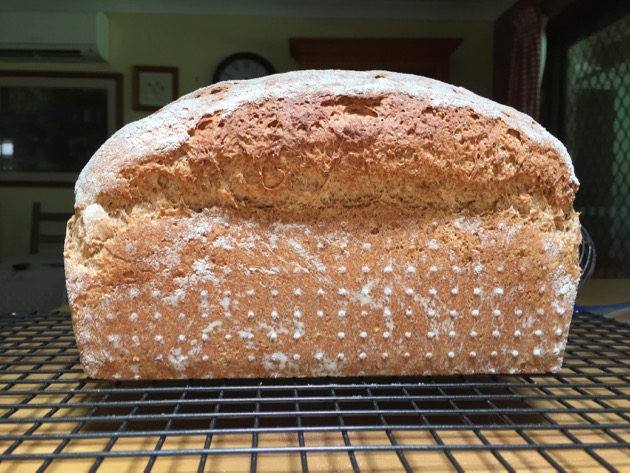I'm happily back into my bread routine again. It didn't take much to kick start me into getting serious about it. The only shop breads I like now are the caraway seed rye from the German Bakehouse at $6.50 a loaf and their 100 percent rye which I think is about the same price. All the others are either tasteless or contain artificial additives and preservatives. The only way for me to get good bread for a good price is to make it myself. I already had my flours, yeast, recipe and equipment, I just had to reorganise my thinking to streamline making, cutting and storing the bread.
The secret to successful baking in the long term is to make it as easy as you can so that you've always got bread on hand and it doesn't take too much time making it. But after a decade of baking bread for my family every day, two things happened that made me rethink what I was doing: we started eating our main meal at lunchtime, and that reduced the amount of bread we needed, and I started writing another book and I had much less time. So when I came back to regular baking, it wasn't a daily task and I had to make sure a loaf remained appetising for two to three days.
The bread above is a rye and spelt loaf. It costs between $2 and $3 to home produce it and the work involved in each loaf takes about 20 minutes. That includes loading the bread machine, kneading the dough, shaping, baking in the oven and slicing the loaf. I use a Sunbeam bread maker and Sunbeam slicer and would recommend them to anyone who wants to set themselves up as a home baker. You don't have to buy new, it doesn't have to be any particular brand; look around for clean secondhand. Or do what I did, start off making it by hand and add appliances if you want to and when you can afford it.
I'm using the same bread recipe as always, I just change the type of flour every so often to get a different taste. I love this loaf, it's 50 percent organic rye and 50 percent organic spelt so it comes out quite soft, with a good flavour and texture which is ideal for sandwiches or for toast. During the hot and humid weather it stores quite well for three or four days in the fridge but with Jamie here, we go through a loaf in about two days.
On the morning I need to bake, I activate two teaspoons of yeast in one teaspoon of sugar and warm water in a tea cup, then load the bread machine with the yeast, four cups of flour, 2 teaspoons of salt and enough water to make a slightly moist dough. I use the machine's dough cycle to mix the dough. All that takes five minutes. When the cycle finishes 90 minutes later, I take the dough out, knead it for a minute, shape it, place it in a bread tin and let it sit until it rises. That takes another five minutes. I keep an eye on the dough because I don't want it to over-rise, it's usually ready to bake in about 15 - 20 minutes. Ten minutes after the bread starts that second rise (the first one was in the bread machine) I turn the oven on to 220C to preheat. Having a hot oven helps the dough rise more in the oven, which gives the loaf a good texture. When the dough has risen enough but not too much, I place it carefully in the oven and turn the temperature down to 200C. About 20 - 25 minutes later, when I see the bread is golden brown and smell the aroma of baked bread, I take it out of the oven and leave the bread, in the tin, sitting on a cooling rack. About 30 minutes later, I remove the bread from the tin and allow it to cool completely on the rack. Doing that takes about a minute. When the bread is cold, I slice it with my slicer, place the cut loaf in a plastic bag - to keep the slices together, and place the sliced loaf in a plastic box with a lid and store it in the fridge. Another five minutes. The bread is now ready to eat. The entire process took about 3½ hours but I was actively working on the loaf for less than 20 minutes. That 20 minutes gives us fresh, healthy, sliced bread.
If you want to start making bread at home, do a little planning and research first to make is as easy as it can be. Find a reliable supplier of fresh flour, either online or close by, find a recipe you want to use that is tried and true. Set up your baking supplies so you've got everything you need and then start working on making the best loaf you can. You probably won't do that the first time you bake, but it won't take long. Work out what you like and don't like about each loaf and improve your method every time you bake.
If this is something you want to do every day, or at least a few times a week, work out short cuts, experiment until you're baking the best bread you're capable of, and then develop your routine around it. Being able to produce good bread consistently is significant skill that will stand you in good stead, increase your confidence as a cook and help you provide healthy food for your family at a price you can afford.
ADDED LATER: This is a good online shop for flours, http://www.farmhousedirect.com.au
ADDED LATER: This is a good online shop for flours, http://www.farmhousedirect.com.au




